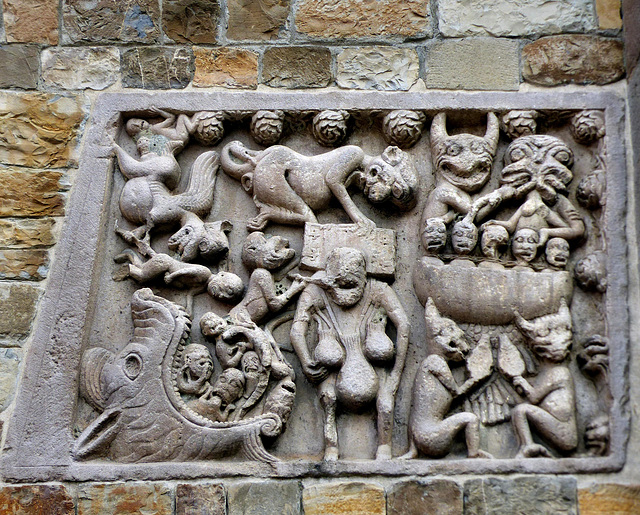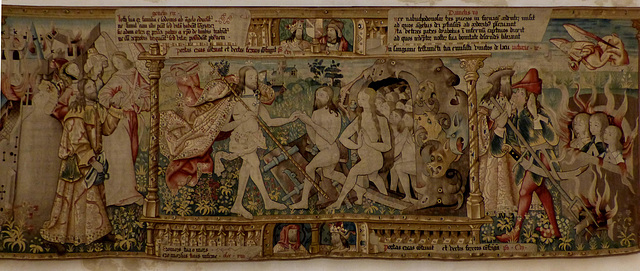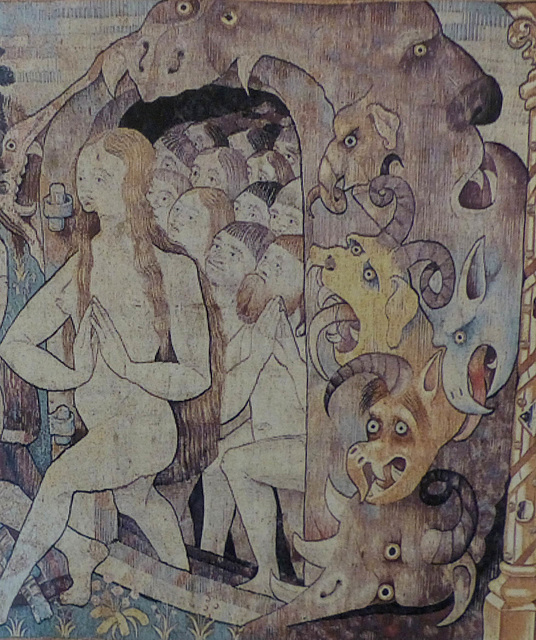
The Jaws of Hell
The Hellmouth is the entrance to Hell. A gaping mouth of a huge monster, an image which first appears in Anglo-Saxon art, and then spread all over Europe.
Ferrara - Cattedrale di San Giorgio
The construction of the Cattedrale di San Giorgio began in the early 12th century, when the city was taken by Matilda of Tuscany (aka "Matilde di Canossa"). When the new cathedral was consecrated in 1135 it was not completed at all. It was - and still is - located in the center of the city.
The lower part of the facade is Romanesque was probably built in the first half of the 11th century. The building process was continued a century later in Gothic style.
A "renovation" of the Ferrara Cathedral done in the early 18th century resulted in a demolition. Only the facade and the outer walls survived. The the medieval interior and the apses, that once existed are lost.
The portal is attributed to Master Niccolò (aka "Nicholaus"), who (or his workshop) worked as well in Verona (San Zeno) and Piacenza (Cathedral).
The upper part of the narthex depicts the "Last Judgement", a popular theme (eg Conques, Autun, Moissac, Sangüesa) here is seen in a delicate style of transition from from Romanesque to Gothic.
Souls rise from open graves. Above them Archangel Michael holds a scale doing the "Weighing of the Souls". A little devil tries to hold down the right side. The sinners leave -naked- to the right side, the good souls - nicely dressed to the left. Above all Christ in a mandorla, showing the "Five Holy Wounds".
I have added the neighbouring carvings (in a larger scale).
To the left the good souls are saved in the "Bosom of Abraham", to the right the poor souls are stuffed by evil devils into the "Mouth of Hell".
Vicofertile - San Geminiano
Vicofertile, located at the old Via Francigena, is meanwhile is a small suburb of the City of Parma.
A church probably existed in Vicofertile already within the 9th century, but the church mentioned in a document from 1039 was smaller than the church seen here. Excavations found the foundations about 50cms under the floor of San Geminiano.
Today´s church was erected around 1200. The roof burned down in 1325, but got rebuilt soon after. The church got modified a couple of times, but a a restoration undertaken in the early 20th century got rid of all interior Baroque additions.
The capitals were probably created around 1220/1230 - and all six are somehow enigmatic. Is the Mouth of Hell in the dark corner??
Fornovo di Taro - Santa Maria Assunta
A church may have been here since Langobardic times, it is documented since 854, when it was already "pieve". In the 11th century the church got rebuilt with three naves and three apses. Some decades later a large narthex was added, to give shelter to the many pilgrims. Subsequently it got integrated into the church.
Over the next centuries many enlargements and modifications were done. The bell-tower was added in 1302. Mid of the 18th century this was a Baroque church.
Between 1927 and 1942 a major renovation was undertaken, reverting the church and the facade to its Romanesque elements.
Many carvings are scattered over the facade, some of them are parts of a medieval pulpit, that was dismembered in the 18th century.
What a horror!
La Chaise-Dieu
La Chaise-Dieu was founded in 1043 by Robert de Turlande. It was named "Casa Dei", from which La Chaise-Dieu developed. From the 11th to the 13th century, the abbey experienced rapid and significant development. When the founder died in 1067, already 300 monks lived here. In the Auvergne La Chaise-Dieu gained importance similar to that of the Burgundian Cluny Abbey. The abbey received many donations from noble families and administered 42 daughter monasteries. Popes who visited the abbey include Urban II, Calixt II, Alexander III. and Innocent II. In 1342, Pierre Roger, who had lived as a monk in La Chaise-Dieu, became Pope in Avignon under the name Clement VI. He financed a new building of the abbey church, in which he was finally buried. The building was completed in 1378 under the pontificate of Gregory XI, a nephew of Clement VI.
Since 1516 La Chaise-Dieu, like most other French abbeys, became "in commendam" so the commendatory abbot drew the revenue of the monastery but without fulfilling the duties of the abbot or even residing at the monastery.
Calvinist troops looted the abbey in August 1562. After most of the monastery buildings were destroyed by fire in 1695, they were rebuilt by the monks in the decades that followed. In 1786, Cardinal de Rohan, who was involved in the "Affair of the Diamond Necklace" was exiled to La Chaise-Dieu. While the abbey had 40 monks at that time, religious life ended at the beginning of the French Revolution.
La Chaise-Dieu is known for the tapestries, once woven to embellish the monks´ choir.
They were commissioned by Jacques de Saint-Nectaire and were woven by a Flemish workshop between 1501 and 1518.
The collection includes 14 tapestries of which two are different and may have been ordered by the abbot for his personal use.
The 12 other tapestries constitute a complete continuation of the Annunciation to the Last Judgment. An inventory prior to the Revolution mentions 18 tapestries, so four tapestries have therefore disappeared.
The tapestries were only exhibited during major liturgical feasts. They were rolled up and kept during the troubles during the Wars of Religion and the Revolution.
In 2013 the tapestries were removed. They got restored and returned to the abbey in July 2019. I was lucky to see them in August 2019.
Seen in the centre is "Harrowing of Hell". Note that part of the Hellmouth is an elephant. To the left is Loth and his family leaving Sodom, to the left Shadrach, Meshach and Abednego in the blazing furnace (Daniel 3.19)
La Chaise-Dieu
La Chaise-Dieu was founded in 1043 by Robert de Turlande. It was named "Casa Dei", from which La Chaise-Dieu developed. From the 11th to the 13th century, the abbey experienced rapid and significant development. When the founder died in 1067, already 300 monks lived here. In the Auvergne La Chaise-Dieu gained importance similar to that of the Burgundian Cluny Abbey. The abbey received many donations from noble families and administered 42 daughter monasteries. Popes who visited the abbey include Urban II, Calixt II, Alexander III. and Innocent II. In 1342, Pierre Roger, who had lived as a monk in La Chaise-Dieu, became Pope in Avignon under the name Clement VI. He financed a new building of the abbey church, in which he was finally buried. The building was completed in 1378 under the pontificate of Gregory XI, a nephew of Clement VI.
Since 1516 La Chaise-Dieu, like most other French abbeys, became "in commendam" so the commendatory abbot drew the revenue of the monastery but without fulfilling the duties of the abbot or even residing at the monastery.
Calvinist troops looted the abbey in August 1562. After most of the monastery buildings were destroyed by fire in 1695, they were rebuilt by the monks in the decades that followed. In 1786, Cardinal de Rohan, who was involved in the "Affair of the Diamond Necklace" was exiled to La Chaise-Dieu. While the abbey had 40 monks at that time, religious life ended at the beginning of the French Revolution.
La Chaise-Dieu is known for the tapestries, once woven to embellish the monks´ choir.
They were commissioned by Jacques de Saint-Nectaire and were woven by a Flemish workshop between 1501 and 1518.
The collection includes 14 tapestries of which two are different and may have been ordered by the abbot for his personal use.
The 12 other tapestries constitute a complete continuation of the Annunciation to the Last Judgment. An inventory prior to the Revolution mentions 18 tapestries, so four tapestries have therefore disappeared.
The tapestries were only exhibited during major liturgical feasts. They were rolled up and kept during the troubles during the Wars of Religion and the Revolution.
In 2013 the tapestries were removed. They got restored and returned to the abbey in July 2019. I was lucky to see them in August 2019.
The elephant is part of the Hellmouth (see prev. upload for a total).
Urschalling - St. Jakobus
The small hamlet Urschalling belongs to Prien am Chiemsee. Located in its centre is St. Jakobus, the parish church. It was built end of the 11th century and later integrated into a fortified castle, that is long gone. Under a thick coat of paint frescoes from the 14th century were discovered.
When these got renovated in the 1940s, another layer of frescoes was discovered below. These frescoes were even 200 years older.
Next to the Baroque statue of Saint Jakobus (James), dressed like a pilgrim, one of the Romanesque frescoes created 1160/1180.
Urschalling - St. Jakobus
The small hamlet of Urschalling belongs to Prien am Chiemsee. Located in its centre is St. Jakobus, the parish church. It was built end of the 11th century and later integrated into a fortified castle, that is long gone. Under a thick coat of paint frescoes from the 14th century were discovered.
When these got renovated in the 1940s, another layer of frescoes was discovered below. These frescoes were even 200 years older.
The "Harrowing of Hell".
Christ releasing Adam, Eve and other righteous from the Hellmouth.
Kottingwörth - St. Vitus
Kottingwörth developed from a settlement on an island ("Werder") in the Altmühl river. The first wooden church may date back to the time of Christianisation. The first stone church was built in the 12th century. It got consecrated between 1183 and 1195. The towers were built between 1250 and 1310. In the first half of the 16th century, the towers were raised. In the years 1760/61, the medieval church building was replaced by a baroque new building.
The oldest part of the church is the basement of the west tower, dated to the 13th century. Around 1310 the choir of the church (now the Vitus chapel) was adorned with frescoes. During the renovation work in the chapel in 1891 these murals were rediscovered under a coat of paint. The paintings are still well preserved.
In the centre, above the Saints, stands Archangel Michael holding the scale. The weighing of souls (psychostasia) is done on Judgement Day. Like mostly, the demons try to interfere with the balance of scales. To the right, the evil souls go to hell.
Kottingwörth - St. Vitus
Kottingwörth developed from a settlement on an island ("Werder") in the Altmühl river. The first wooden church may date back to the time of Christianisation. The first stone church was built in the 12th century. It got consecrated between 1183 and 1195. The towers were built between 1250 and 1310. In the first half of the 16th century, the towers were raised. In the years 1760/61, the medieval church building was replaced by a baroque new building.
The oldest part of the church is the basement of the west tower, dated to the 13th century. Around 1310 the choir of the church (now the Vitus chapel) was adorned with frescoes. During the renovation work in the chapel in 1891 these murals were rediscovered under a coat of paint. The paintings are still well preserved.
The weighing of souls (psychostasia). Like mostly, the demons try to interfere with the balance of scales. To the right, the evil souls line up in front of the Hellmouth. Even a bishop (mitra) and a monk (tonsure) are among the roped, well dressed doomed.
Jump to top
RSS feed- Latest items - Subscribe to the latest items added to this album
- ipernity © 2007-2024
- Help & Contact
|
Club news
|
About ipernity
|
History |
ipernity Club & Prices |
Guide of good conduct
Donate | Group guidelines | Privacy policy | Terms of use | Statutes | In memoria -
Facebook
Twitter










